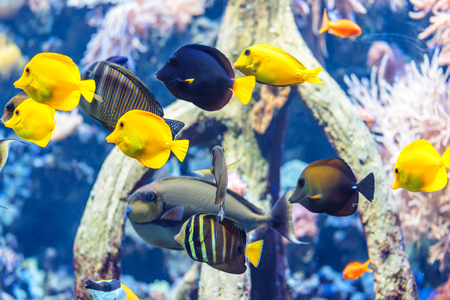Why Set Up a Home Aquarium for Children?
Introducing a fish tank into your home is more than just a charming addition to the living room; it’s an engaging way to nurture curiosity and responsibility in children. For many British families, finding activities that are both educational and emotionally rewarding can be a challenge, especially during rainy weekends or school holidays. A child-friendly aquarium serves as a daily source of fascination, encouraging youngsters to observe, ask questions, and learn about the natural world from the comfort of their own home. Beyond its educational value, watching colourful fish glide through the water has a calming effect, helping children unwind after a busy day at school. Caring for aquatic pets also teaches little ones about routine, empathy, and the importance of gentle handling—skills that translate well into other areas of life. In short, setting up a safe and educational fish tank at home can provide lasting benefits for children while creating peaceful moments for the whole family to enjoy together.
Choosing the Right Fish and Equipment
Setting up a child-friendly aquarium at home starts with choosing beginner-friendly fish and suitable equipment, especially with safety and accessibility in mind for little ones. The UK offers a wide range of pet stores, both on the high street and online, where you can find everything needed for a safe and educational setup.
Beginner-Friendly Fish Species
For families new to fishkeeping, it’s best to select hardy species that thrive in varied conditions and are easy to care for. Below is a handy table outlining some ideal choices for UK households:
| Fish Species | Tank Size Needed | Temperament | Special Notes |
|---|---|---|---|
| Zebra Danio | 45 litres+ | Peaceful, active | Tolerant of water changes; great for beginners |
| Platy | 40 litres+ | Friendly, colourful | Easy to breed; livebearers add interest for kids |
| Guppy | 40 litres+ | Lively, peaceful | Vibrant colours; small but resilient |
| White Cloud Mountain Minnow | 30 litres+ | Docile, schooling fish | Copes well with room temperature tanks |
| Corydoras Catfish | 50 litres+ | Gentle bottom-dweller | Keeps tank clean; fun to watch as they scavenge |
Selecting the Perfect Tank and Gear in the UK
Aquariums come in various sizes and materials—glass is classic, but acrylic tanks are lighter and less likely to shatter if accidentally knocked. For families with young children, an acrylic tank with rounded corners is often safest. Always choose a tank with a secure lid to prevent curious fingers from dipping into the water or pets from sneaking a sip.
Essential Equipment Checklist:
- Aquarium filter: Keeps water clean and healthy for your fish.
- Aquarium heater (if keeping tropical species): Maintains consistent temperature.
- Aquarium lighting: Highlights colours and supports plant growth.
- Aquarium stand: Sturdy support at an accessible height for children to view safely.
- Aquarium thermometer: Easy monitoring of water temperature.
- Aquarium net & cleaning tools: For safe maintenance without hands entering the tank too often.
- Treated tap water or aquarium-safe water conditioner: Ensures safe water quality straight from the tap—widely available in UK shops like Pets at Home or Maidenhead Aquatics.
Top Tip:
If your child is very young, position the tank out of reach but within sight—perhaps on a sturdy cabinet in the living room. Involve children in feeding routines and observation rather than cleaning or handling equipment at first. This keeps things fun and safe while fostering responsibility.
![]()
3. Creating a Safe and Stimulating Environment
Ensuring your aquarium is both engaging and child-friendly is essential for a happy home. Start by positioning the tank out of reach of very young children—think on a sturdy, waist-high stand or within a secure alcove. This minimises the risk of little hands toppling the tank or tampering with equipment.
Tips for Child-Proofing Your Aquarium
Consider fitting a lockable lid to prevent curious fingers from accessing the water or feeding the fish unsupervised. Keep all electrical equipment, such as heaters and filters, safely tucked away at the back of the tank or behind furniture to avoid accidental unplugging or fiddling.
Selecting Safe Tank Decorations
Choose decorations made from non-toxic materials specifically designed for aquarium use. Avoid sharp-edged rocks or ornaments that could harm both your fish and your child if handled. Smooth pebbles, silk plants, and large, colourful caves can create an enriching underwater landscape while keeping safety in mind.
Ensuring Protection for Both Fish and Children
Remember, fish are sensitive to sudden changes and loud noises, so place the tank somewhere calm and stable—away from direct sunlight, radiators, and high-traffic areas like hallways. Teach your children about gentle observation rather than tapping on glass or startling the fish. By creating a safe and stimulating aquarium environment, you’re offering your family an educational adventure that’s equally fun and secure.
4. Educational Activities and Observation Tips
Transforming your child-friendly aquarium into a living classroom is easier than you might think. With a bit of creativity, your aquarium can offer endless opportunities for hands-on learning and exploration. Here are some engaging activities and observation tips that will not only entertain little ones but also nurture curiosity and responsibility.
Keep a Fish Diary
Encourage your children to keep a fish diary where they jot down daily observations about their aquatic pets. This could include noting any changes in behaviour, colour, or the tank environment. It’s a fantastic way to boost their writing skills while helping them spot patterns over time. A simple table like the one below can help structure their entries:
| Date | Fish Name | Behaviour Noticed | Tank Conditions |
|---|---|---|---|
| 01/07/2024 | Bubbles | Swimming near the top | Water clear, temp 24°C |
| 02/07/2024 | Sparkle | Hiding behind plants | Water clear, temp 24°C |
Simple Science Experiments
Your home aquarium provides a great platform for basic science experiments suitable for children. Try these safe and easy ideas:
- Water Temperature Changes: Measure how fish behaviour alters with slight temperature changes (always staying within safe limits for your species).
- Feeding Time Trials: Test how quickly each fish finds food at different times of day, teaching kids about routines and animal habits.
- Aquatic Plant Growth: Track how fast live plants grow by measuring them weekly, introducing concepts of biology and plant care.
Create an Observation Chart
An observation chart displayed near the aquarium encourages regular engagement and allows children to visually track fish health, feeding times, and cleaning schedules. Here’s an example layout:
| Day | Fed Fish? | Cleaned Tank? | Fish Health (Happy/Sad) |
|---|---|---|---|
| Monday | Yes | No | Happy |
| Tuesday | Yes | No | Happy |
| Wednesday | Yes | Yes (partial) | Happy |
Tips for Young Naturalists:
- Name Your Fish: Naming encourages bonding and makes it easier to identify individual behaviours.
- Create Story Time: Let children invent stories about their fish’s adventures – perfect for rainy British afternoons!
- Aquarium Art Sessions: Have drawing sessions where children sketch what they see in the tank, fostering observation skills and creativity.
- Tank Talks: Schedule short family discussions about what’s happening in the aquarium, using simple British English terms to build vocabulary and confidence.
This interactive approach turns fishkeeping into an enriching family hobby while supporting educational development in a fun, accessible way.
5. Routine Care and Child Involvement
Keeping your home aquarium healthy isn’t just about the initial setup – it’s all about regular care, and this is a fantastic opportunity to get children involved in a safe, educational, and enjoyable way. Developing a manageable routine means everyone knows what to expect, and it helps little ones learn responsibility while keeping the fish happy and thriving.
Creating a Simple Care Schedule
Start by planning a weekly timetable that fits easily into your family life. For most tanks, basic tasks include feeding the fish daily, checking water temperature and equipment every few days, and changing part of the water once a week. Pop a colourful chart on the fridge or use a family planner app to remind everyone of their duties. Keeping things consistent means less stress for both you and your aquatic pets.
Safe Ways for Children to Get Involved
Children love feeling helpful, so let them take charge of age-appropriate jobs under adult supervision. Younger kids can sprinkle in pre-measured fish food (no overfeeding!), help wipe down the outside of the tank, or tick off tasks on your care chart. Older children might test the water quality with simple kits or help with gentle cleaning and plant care.
Supervision Is Key
No matter how keen your little ones are, always supervise their involvement. Explain why clean hands are important before touching anything near the tank, and never let children handle electrical equipment or chemicals. Make each task a mini learning moment – talk about what you’re doing and why it matters for the health of your fishy friends.
Making It Fun and Rewarding
Turn routine chores into bonding moments: sing a song while feeding time rolls around, or set up a sticker reward system for completed tasks. As children see their efforts pay off with happy, active fish, they’ll feel proud and more connected to their underwater world – all while picking up valuable life skills along the way.
UK Resources and Local Aquarium Shops
If you’re setting up a child-friendly aquarium at home in the UK, having access to trustworthy resources and local experts can make all the difference. Here’s a handy guide to some of the best UK-based pet stores, community groups, and family-friendly events that can support your fish-keeping journey.
Top Reputable UK Pet Stores for Aquarium Supplies
- Pets at Home: With locations nationwide, Pets at Home offers an excellent range of beginner aquariums, child-safe accessories, and knowledgeable staff who can answer your questions about tank setup and maintenance.
- Maidenhead Aquatics: This well-known chain specialises in aquatic supplies. Their stores feature helpful displays, friendly advice for families, and regular educational events for budding young aquarists.
- Aquatic Design Centre (London): A favourite among Londoners, this shop is great for sourcing high-quality tanks, child-safe decorations, and expert guidance tailored to UK homes.
Community Groups & Family Events
- The British Aquarist Society: One of the oldest fishkeeping clubs in the UK. They host regular meetings, fun workshops for children, and are a valuable source of tips and support for families new to the hobby.
- Local Facebook Groups: Search for “UK Fishkeeping” or your town’s name plus “Aquarium Club” on social media to find friendly communities where you can ask questions, swap equipment, or even attend local meetups with other families.
Educational Days Out
If you’d like some inspiration before setting up your own tank, consider visiting one of the UK’s public aquariums such as The Deep in Hull or Sea Life London Aquarium. These attractions often run interactive sessions perfect for kids and offer insights into ethical fish care and aquatic conservation.
Final Tip
Don’t hesitate to reach out to your local pet store or community group if you need advice on making your home aquarium safe and enjoyable for children. The UK’s vibrant aquarist community is always happy to help new families join the hobby!


